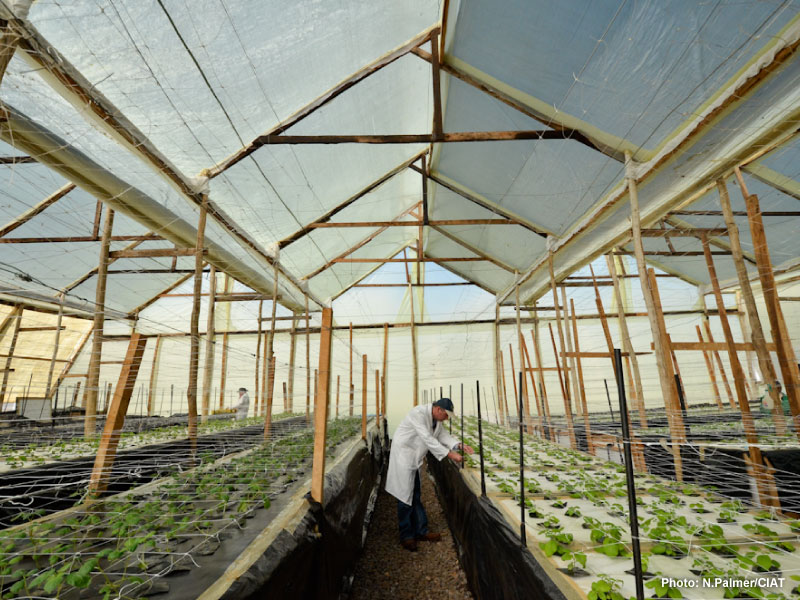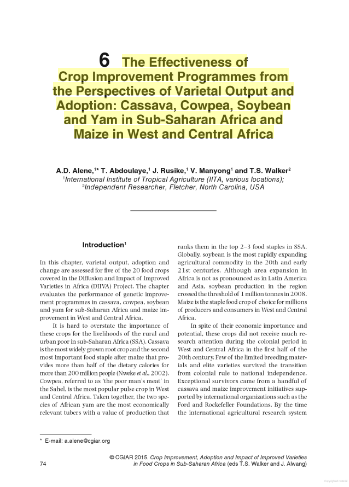RTB crop breeding in Africa shows wide-scale adoption of improved varieties
 Crop breeding and the dissemination of improved varieties has been a cornerstone of research for development in Sub-Saharan Africa (SSA) for decades, and RTB scientists contributed to research on the impact of this work which is featured in the book Crop Improvement, Adoption, and Impact of Improved Varieties in Food Crops in Sub-Saharan Africa, published in 2015. This ambitious review contains a wealth of information on decades of cassava, yam, potato and sweetpotato improvement in SSA, and it holds lessons for strengthening future efforts to tap the potential of RTB crops for improving food security, nutrition and livelihoods.
Crop breeding and the dissemination of improved varieties has been a cornerstone of research for development in Sub-Saharan Africa (SSA) for decades, and RTB scientists contributed to research on the impact of this work which is featured in the book Crop Improvement, Adoption, and Impact of Improved Varieties in Food Crops in Sub-Saharan Africa, published in 2015. This ambitious review contains a wealth of information on decades of cassava, yam, potato and sweetpotato improvement in SSA, and it holds lessons for strengthening future efforts to tap the potential of RTB crops for improving food security, nutrition and livelihoods.
The book, which covers the development and distribution of improved varieties of 20 crops in 30 countries, grew out of the ‘Diffusion and Impact of Improved Varieties in Africa’ study funded by the Bill & Melinda Gates Foundation. It confirms the important role that RTB centers have played in strengthening crop improvement in SSA, but also shows that it takes a long time to develop and disseminate improved varieties, which is why RTB has prioritized innovations that accelerate the breeding process.
Cassava is the second most consumed staple food in SSA, and the book documents the important role that IITA has played in improving that crop. Of the 367 improved cassava varieties released in 17 SSA countries between 1970 and 2010, more than 80% were IITA-bred or from IITA parents. According to expert estimates, IITA-related varieties were grown in approximately 30% of the total cassava area in SSA in 2009. IITA’s yam improvement program has also had a significant impact, with IITA-related varieties accounting for 13% of the 78 yam varieties developed or identified for release between 1970 and 2010.
The book also documents CIP’s important role in potato and sweetpotato improvement in SSA. CIP was involved in the development of 42 of the 45 improved potato varieties released in Ethiopia, Kenya, Malawi, Rwanda and Uganda over the past decade. And of the 60 new sweetpotato varieties released in Burundi, Mozambique, Rwanda, Tanzania and Uganda since 2000, 19 were CIP-bred and seven were bred by national agricultural research organizations using CIP parents.
Many improved varieties have low adoption rates, and it is hard to determine whether that is due to problems with the varieties or inadequate dissemination. Yet some are widely adopted, and they offer lessons for breeding programs. One success story is the potato variety Victoria, which was selected by a CIP breeder in Uganda for release in the 1990s. By 2010, high-yielding, early-maturity Victoria covered more than half of Uganda’s potato-growing area and was the second most popular variety in Kenya. There are many more success stories, such as the cassava variety Rugero (MM96/5280), released in Burundi in 2001, which covered 16.4% of Burundi’s cassava area in 2009; or the variety Sauti (CH92/077), released in Malawi in 2002, which covered 16.8% of that country’s cassava area in 2009.
Weighted average adoption of improved potato varieties in Ethiopia, Kenya, Rwanda and Uganda in 2010 was 37%, but the weighted average adoption of improved sweetpotato varieties in Burundi, Mozambique, Rwanda, Tanzania and Uganda was just 7% of the sweetpotato area. However, crop area may be a poor indicator of the success of CIP’s efforts to get vitamin A-rich orange-fleshed sweetpotato varieties into the hands of the region’s poorest farmers, especially women. In Uganda, for example, where sweetpotato covers just 2.6% of agricultural land, 8% of households grow the crop.
Nevertheless, cultivation of improved potato and sweetpotato varieties needs to be expanded in SSA, and CIP is working on multiple fronts to achieve this. The book will contribute to improving such efforts, and it has arrived just as RTB crop breeders are tapping the potential of genomic data and other scientific advances to accelerate the breeding of the improved varieties that African farmers need.
Related links

